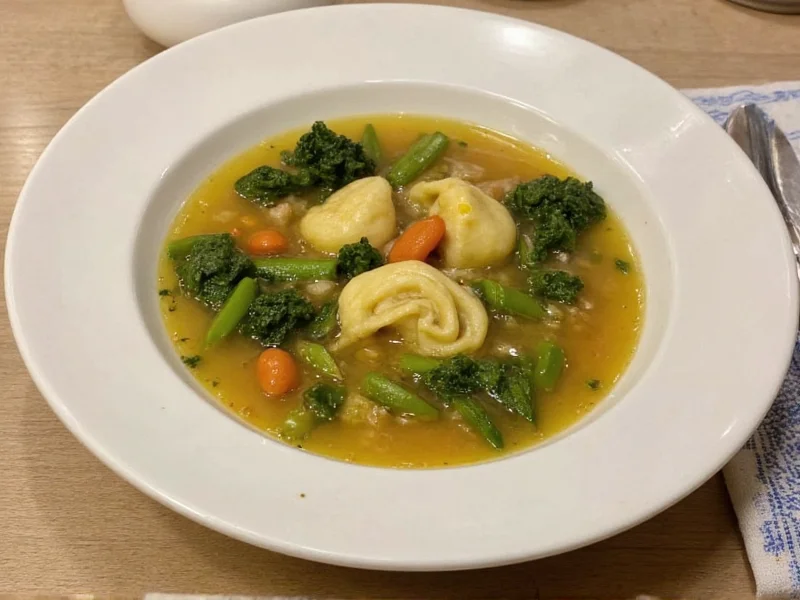The Essential Components of Perfect Kale and Tortellini Soup
Creating an exceptional kale and tortellini soup requires understanding each element's role. Unlike many pasta soups where ingredients simmer for hours, this dish shines through simplicity and fresh components. The magic happens when quality broth meets perfectly timed additions - adding tortellini too early causes mushiness, while kale benefits from just enough cooking to soften without losing its vibrant color and nutrients.
Core Ingredients and Their Purpose
Each component serves a specific function in building flavor and texture. Understanding these roles helps with successful substitutions when needed. The following table details essential ingredients and their culinary purpose:
| Ingredient | Quantity | Function in Recipe | Substitution Options |
|---|---|---|---|
| Curly or Lacinato kale | 4-5 cups, chopped | Provides earthy flavor and nutritional boost | Spinach (add at end), Swiss chard |
| Cheese or meat tortellini | 18-20 oz package | Creates satisfying heartiness | Homemade tortellini, other filled pastas |
| Good quality broth | 4-6 cups | Forms flavor foundation | Homemade stock, mushroom broth |
| Garlic and onion | 3 cloves, 1 medium | Builds aromatic base | Shallots, leeks |
| Olive oil | 2 tbsp | Carries flavors and richness | Butter, avocado oil |
Step-by-Step Preparation Guide
Follow this method for consistently excellent results. The entire process takes approximately 25-30 minutes from start to serving.
Preparation Phase (5 minutes)
Wash kale thoroughly under cold water, then remove the tough center stems by folding each leaf in half and slicing along the stem. Chop leaves into bite-sized pieces. Mince garlic and finely dice onion. If using canned beans for added protein, drain and rinse them.
Cooking Sequence (20-25 minutes)
- Heat olive oil in a large pot over medium heat until shimmering but not smoking
- Add onions and sauté until translucent (about 5 minutes), stirring occasionally
- Incorporate minced garlic and red pepper flakes, cooking until fragrant (about 30 seconds)
- Pour in broth and bring to a gentle simmer
- Add kale and any additional vegetables like carrots or celery
- Cook until kale reaches desired tenderness (5-7 minutes for tender texture)
- Stir in tortellini and cook according to package directions (typically 5-7 minutes)
- Remove from heat just before tortellini becomes fully tender to prevent overcooking
- Stir in lemon juice and grated Parmesan if using
Serving and Storage Recommendations
Serve immediately in pre-warmed bowls to maintain temperature. The soup performs best when tortellini has slightly al dente texture. For optimal flavor development, let the soup rest for 5 minutes after cooking before serving.
Store leftovers in an airtight container in the refrigerator for up to 3 days. Note that tortellini will continue absorbing liquid, so you may need to add additional broth when reheating. Freezing is not recommended as the pasta becomes mushy upon thawing.
Variations for Different Dietary Needs
This versatile recipe adapts well to various preferences while maintaining its essential character:
- Vegetarian kale and tortellini soup: Use vegetable broth and cheese tortellini, adding white beans for protein
- Vegan adaptation: Substitute cheese tortellini with mushroom-filled variety and use nutritional yeast instead of Parmesan
- Protein boost: Add cooked Italian sausage or shredded chicken during the last 5 minutes of cooking
- Gluten-free version: Use gluten-free tortellini and ensure broth is certified GF
- Lighter preparation: Reduce tortellini quantity and increase kale and additional vegetables
Common Mistakes to Avoid
Even simple recipes can go wrong without proper technique. For the best easy kale and tortellini soup experience:
- Don't add tortellini to boiling liquid - maintain a gentle simmer to prevent bursting
- Avoid overcooking kale, which turns it bitter and loses nutritional value
- Never skip the acid component (lemon juice or vinegar) which brightens flavors
- Don't use dried herbs instead of fresh when possible - fresh herbs make a noticeable difference
- Avoid adding salt too early; broth often contains sufficient sodium
Nutritional Benefits of Kale and Tortellini Soup
This satisfying soup delivers impressive nutrition without feeling like "health food." Kale contributes significant amounts of vitamins A, C, and K, plus calcium and antioxidants. When prepared with cheese tortellini, the soup provides complete protein and calcium. Adding white beans creates a vegetarian protein powerhouse with fiber that aids digestion. The healthy fats from olive oil help absorb fat-soluble vitamins from the kale.
Perfect Pairings for Your Soup
Complete your meal with these complementary options:
- Crusty whole-grain bread for dipping
- Simple arugula salad with lemon vinaigrette
- Roasted vegetables like carrots or Brussels sprouts
- Light pinot grigio or crisp cider











 浙公网安备
33010002000092号
浙公网安备
33010002000092号 浙B2-20120091-4
浙B2-20120091-4